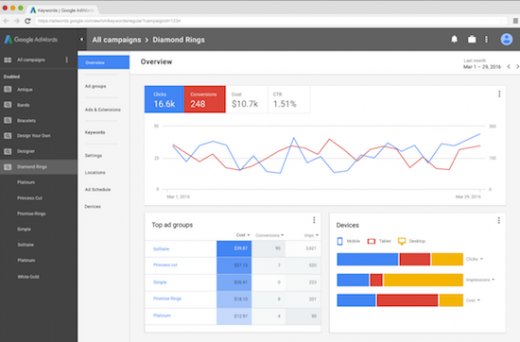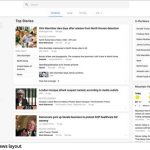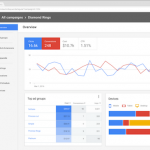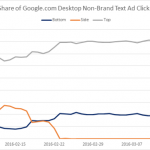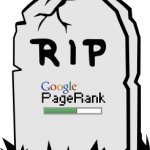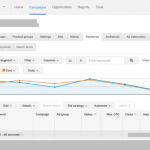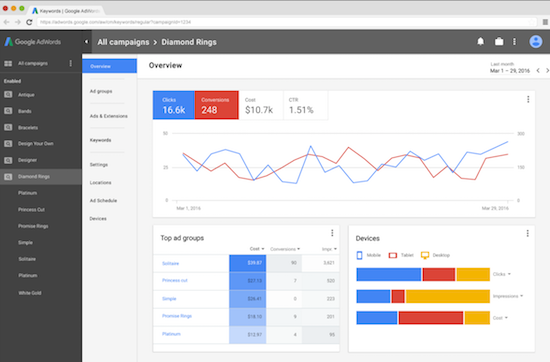Google’s Big Announcement: How The Shift to Mobile Ignites the Future of Google AdWords and Analytics
May 25, 2016
“Mobile Changes Everything”
That was the theme for this year’s Performance Summit presented by executives of Google. Based off of the micro-moments campaign Google began last year, a “mobile-first world” continues to be the focal point of product development and enhancement for Google AdWords and the new Google 360 Suite.
A number of product announcements and marketplace statistics were provided during Google’s presentation (May 28, 2016), paving the way for how digital marketers will prioritize and adjust their strategies, campaign structure, and goals. Here are some of the exciting enhancements to come:
AdWords Interface Rebuild
Google expressed that accounting for mobile in your strategy is absolutely not the same idea as designing for mobile. Taking this to heart, the debut of their new AdWords interface, which will begin to rollout later this year, allows marketers to create campaigns based on the goal or action they want customers to perform.

For example, a campaign manager can create a new search campaign and specify if they’re trying to drive phone calls, app downloads, web visits, and more.
Google also previewed a new dashboard function that will be useful for obtaining a high-level overview of the best and worst performing campaigns, popular times of the day where visitors interact with your brand, and the most popular devices people use to view or click through ads.

Changes to Paid Search
Perhaps an even more exciting feature is the ability to create individual bidding adjustments for all devices (mobile phones, tablet, and desktop). Account managers can now create campaigns based on any device anchor they choose and, if they wish, create individual bidding adjustments for other devices they feel may play a more or less important role in driving web traffic and conversions.
To accommodate the use of mobile devices, Google plans to change the ad structure of paid search ads. Account managers can now create ad copy with longer headlines and use up to 80 characters in the ad description. Google stated that early testers of this new ad structure saw an increase in click-through rate of over 20%.
The most widely applauded announcement for search was the new Similar Audiences For Search feature. This function will allow ads to be targeted toward people that made similar searches to those who visited your website. For example, if a visitor clicked on your ad after they searched for “high-quality sunglasses,” other searchers who had a similar query in the past could be targeted with your ads. Fiat Chrysler Automobiles tested this new feature and saw a click-through rate increase of 5%.
Lastly, Google announced that in the coming months they will debut demographics for search ads. This will allow marketers to target specific age groups and genders in their paid search campaigns.
Changes to Display
Today, the Google Display Network reaches over 90 percent of Internet users on over 2 million publisher websites and applications. In the near future, this reach will become considerably larger due to Google’s new cross-exchange inventory. It will allow marketers to have the same accuracy and dependability they have on the GDN but with a wider range of websites and apps around the world.
On the creative side, Google simplified advertising on their Display Network (GDN). Now marketers only need to provide a headline, URL, description, and image, and GDN will take care of the rest by making and adjusting creative for any time an ad may appear on multiple devices.
Advertising on Google Maps
The new advertising enhancements for Google Maps is the most forward-thinking update announced. It helps marketers address the immediate wants and needs of consumers, and will increase in-store traffic and conversions for many businesses globally.
For advertisers using location extensions, there will be an option to create branded pins on google.com, Google Maps, and the maps app. Searchers will see in-store promotions, local inventory, and a local inventory search function.

For example, a local clothing store could link their inventory to the ads “business page.” This way, interested shoppers can check inventory to determine if what they’re looking for is in stock. This new function is intended to drive more in-store conversions from digital ads.
Furthermore, if someone is using the maps app to navigate to a destination, these promotional ads and pins can be displayed during their route to entice people who may have extra time to come in and purchase. For example, a coffee shop could use this function and offer a 10% off promotion in the business page of the ad, which may entice people on their way elsewhere to stop in and grab a drink. Very exciting!
Analytics Changes
The last major announcement during the summit was a live demonstration of the new Data Studio 360, available now for Adometry and Premium Analytics customers and Google Analytics’ new Data Assistant.

Data Studio 360 brings in data points from YouTube, Google Analytics, AdWords, and other sources to create ad hoc reports that are accessible and editable by multiple parties simultaneously. Reports that may have taken hours to create in the past now take a matter of minutes to generate and are presented in a customizable, elegant format.
Google Analytics’ Data Assistant, which debuted at Google I/O last week, allows users to ask intuitive questions about their data in a nature language format directly in Analytics. Examples include, “How many unique visitors from Google organic did my website have in April?” and “What were my best selling products in April?” In a matter of seconds Data Assistant provides the information, creating significant time savings for users who used to have to generate a report in the interface.

We’re excited to see how marketers use these new enhancements and reports to better optimize and adjust their mobile strategies and look forward to seeing them rollout over the next year! If you are interested in learning more about how to attribute and analyze offline call conversions from your search and display ads to better optimize ROI, please check out our new eBook, The Digital Marketer’s Guide to Call Attribution.
Digital & Social Articles on Business 2 Community
(44)

